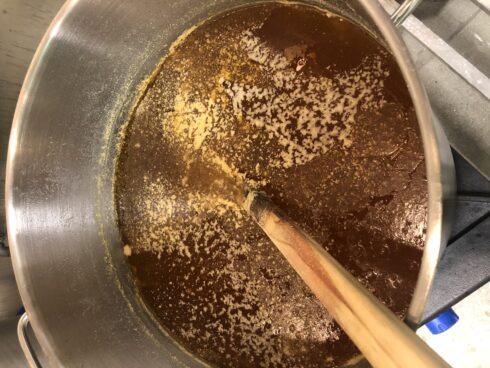Thank you for following along on this 2-part series following the work of Nick Van Nordheim who is the owner Full Circle Ghee. As I am always incorporating ghee into my recipes, I have really enjoyed ordering from Nick’s company. The way that he creates his ghee is so pure, that the care he has really shines through in the flavor. In the previous blog, Nick gave us more of a look into his process with making the product, and he walked us through the steps. Now, you will be hearing more about his passion, inspirations, and drive for creating!
Nick’s path has been one of passion and interest in the way our ancestors lived. Being introduced to the Ancestral Cuisine through, he became fascinated with how the process of cooking the ideal meal was something more akin to what our ancestors ate rather than the artificial, sugar laden, and fat phobic food that he had grown up with. It took him aback to see the principles that our ancestral relatives used when cooking in order to abate disease and nourish themselves. With this visual, Nick took the path of fermentation to try and reproduce those products included in their diet. Fat to him seemed to be something that was nearly demonized in the American culture. This was quite different than the highly processed and nutrient void fats that we were all told were “better” for us. Nick could not wrap his mind around a product like butter and milk being worse for us than canola oil, which undergoes intense chemical and mechanical processes to be produced. To him, it seemed dubious at best, and nefarious at worst. This suspicion is what caused him to dive into traditional fats and their methods of production, ranging from how the animals were raised, to how the fat was processed or created. Being the son of a vegetarian, he always opted for the fats that reduced harm to animals, which eventually led him to ghee. He added, “I truly think the path found me, and not that I found it”!

Once again, I have summarized some key points that were mentioned by Nick in our conversation. You may be a ghee user, like myself, but it is always important to know what exactly we are putting into our bodies. So many labels out there display all the not so healthy things we are ingesting. Especially with being celiac, we need to be extremely careful, as we want to avoid gluten. Nick really has laid it all out on the table for us, and that is why I am so fond of his company. Enjoy the rest of your read, as you can see the discussion on his flavors and his passion for his work!
Browned Butter
The Browned Butter is a traditional French product called Beurre Noisette. What differs from the traditional product and mine is the way I produce it. Traditional Browned Butter is made to include the burnt milk solids as a method for to get more flavor into it. This would mean that it would include dairy products, which is not what I wanted. I produce the same product but by way of a ghee-type method in which I cook down and filter out all the remaining milk solids (proteins and sugars) leaving just the oil that has all the nutrient benefits and flavor of the original. It is made from the same butter that I use to produce our original ghee, but has a little more care involved to increase the toasted nut flavors as well as removing all of the milk and its major allergens. I love to use this when I want just that little bit of extra flavor and depth in my cooking and baking.

Inspiration
With all of the Ghee I produce, I try and look back into culinary and cultural history for my inspiration. In my own nutrition education, I found that looking back to our ancestors provided much more satisfactory ingredients and flavors that did not include mass production, excess sugars, and all-around artificial components. My journey through ancestral cooking led me to this glorious Browned Butter and the flavors that came from a completely natural process of heating butter and letting the intrinsic flavors come through. I loved that such a simple product like butter could be changed into something so magnificent and have such depth! In my own trials I found that this product was basically the same as ghee, which I had already fallen in love with. I started to make the Browned Butter in its traditional manner with keeping the milk solids, but I decided to put it through my filtering process to make sure that they were not included, and I honestly don’t miss the milk solids at all because the flavor is in the fat!!
Cultural Use
Keeping this same principle of ancestral cooking in mind, I really looked into more cultural uses of ghee, in its many forms. Ghee does come from India, but there are many cultures that use the same product made in a slightly different way. For instance, I found that in Ethiopia they make a product called Niter Qibbeh, which roughly translates to, “Spiced Butter.” In the Ethiopian equivalent of making ghee, they introduce spices into the pot to flavor it with whatever they put in there. Traditionally, they use a mixture of spices, herbs, and aromatics but for mine I chose to go the route of an Indian curry blend. In my opinion, the spices and herbs used in Niter Qibbeh were not really known as a flavor profile in our region of Southern California and I wanted to produce something that was similar in process but was something that was more relatable outside of the cultural context. Although the spiced ghee I produce is called “Ethiopian Spiced” it is more reminiscent of a curry flavor that is more recognizable, but I use the name to condone its origins and provenance. In Ethiopia, as in India, ghee is typically produced in the home and has varying tastes from whomever is making the product. Some people may like a little more ginger zing, some may like a little more of the meat cumin flavor, but overall it is the same product. I felt that I could use the same method with my own custom blend to resemble something that everyone could understand when tasting.
I used this same method when I decided to make another flavor, and I landed on the Mediterranean region. In this area, the use of herbs is more common. The Italian Herbed was born to reflect the use of the native herbs and flavors that are common in the cuisine found there. Made in the same process, but with a different flavor profile, I was able to create the Italian Herbed Ghee and produce a flavor that just screams garlic bread seasoning and pizza! As for other flavors, I have a few ideas, but nothing really concrete as there are a lot of flavors to choose from, but some just don’t do so well heated and are really volatile. I really have a lot to say about ghee and how I came to find such a beautiful product!
Thank you so much Nick for shedding some light on your ghee. Your dedication and passion for your ghee is so refreshing, and I can definitely taste the love and care that goes into your creations.
Try using ghee instead of butter to make a delicious recipe like my macaroni recipe.
From our home to yours, Tina Turbin
If you have any questions or suggestions just email me at Info (at) TinaTurbin (dot) com.








